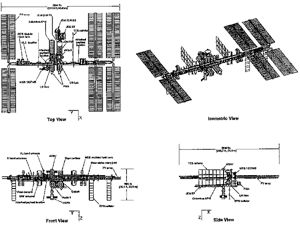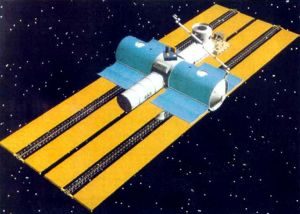
Home - Search - Browse - Alphabetic Index: 0- 1- 2- 3- 4- 5- 6- 7- 8- 9
A- B- C- D- E- F- G- H- I- J- K- L- M- N- O- P- Q- R- S- T- U- V- W- X- Y- Z
Space Station Options 1993
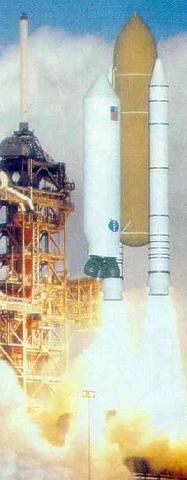 Space Station C4 Space Station Option C4. Credit: NASA via Marcus Lindroos |
Status: Study 1993.
These were:
It would have included no fewer than 136 experiment racks - nearly three time as many as 'Fred' and far more than the Option C solar arrays could support. But its microgravity environment was comparatively poor since the Station would have to rotate to keep its solar panels facing the Sun or else the power would vary. The design made adding more solar panels very difficult. The Europeans, Japanese and Canadians disliked this option since would have to change the electrical, thermal control and data management systems of their modules - if they could be accommodated at all. The international contributions would also be rendered largely useless (e.g. Canada's robotic arm would also be of little value since little on-orbit assembly would required).
The Option C Space Station would have been launched in one piece on a new unmanned Shuttle-derived heavy-lift rocket. The design was regarded as a very high-risk venture since the Station would have to be developed essentially from scratch and tested in a very short time, and it would rely on a new launch vehicle that would have to work on its maiden voyage (NASA was going to use cannibalized parts from the Shuttle Orbiter 'Columbia' to save money). Nonetheless, the 'blue ribbon' selection panel endorsed Option C along with Option A. NASA proposed to farm out the construction of the 'can' to Russia in order to save money. The Russians declined, however, since they felt the bid wasn't detailed enough.
Later, additional laboratories and a habitation module could be added to create the complete Option A Space Station shown here. A major drawback was the limited capability for scientific research, particularly for sensitive microgravity experiments since the Station periodically (every 2-3 months) would have to reorient itself 90 degrees to keep solar panels pointing toward the Sun. This would interrupt materials science regularly. Consequently, the Clinton Administration promised to use the same 'alpha' solar panel joints as Option B. The total estimated cost in 1994-98 was $13.3 billion, considerably higher than the $9-billion Space Station requested by the President in March 1993. NASA was asked to report back in September 1993 since the current Option A design was not detailed enough for an accurate assessment of its user capabilities to be made.
1993 SPACE STATION OPTIONS SUMMARY ------------------------------------------------------------------- COSTS ($ billions) Freedom A/Bus-1 Option-B Option-C R-Alpha ------------------------------------------------------------------- -FY 1994-98 $15.8 $13.3 $13.3 $11.9 $10.5 -FY'94 to assembly complete $22.1 $17.0 $19.3 $15.2 $19.4 -Ops. & payloads $25.0 $13.5 $15.1 $10.2 ? -Total lifetime cost incl.marginal STS $65 $47 $50 $41 flight cost -Total lifetime cost $101 $80 $87 $65 incl.average STS flight cost ------------------------------------------------------------------- MILESTONES Freedom A/Bus-1 Option-B Option-C R-Alpha ------------------------------------------------------------------- -1st element launch 3/96 10/97 10/97 9/99 6/97 -Man-tended capacity 6/97 4/98 12/98 - 8/97 -International modules 12/99 12/99 3/01 7/00 4/00 -Permanent crew 6/00 9/00 12/01 11/99 9/97 -Assembly complete 9/00 9/00 12/01 1/01 10/01 ------------------------------------------------------------------- PERFORMANCE Freedom A/Bus-1 Option-B Option-C R-Alpha ------------------------------------------------------------------- Orbit inclination 28.5 28.5 28.5 28.5 51.6 Crew research hr/yr 6866h 6724h 6566h 6866h Total power (kW) 68.3 57 68.3 61.5 105 User power (kW) 34.2 31 40.3 40.9 < 45 Habitable volume (m3) 878 760 878 1117 1200 Equipment racks system racks 65 59 65 50.5 51* user racks 45.5 39 45.5 72 33* user racks @ <1uG 29 8 29 40 ? Assembly EVA, h. 340h 224h 311h 24h 224h Annual maintenance EVA 240h 187h 253h 80h 197h Total assembly flights 20 16 20 10 14+12 Russian. Logistics flights/yr. 4 6 6 6 7 * = does not include Russian equipment racks.
Article by Marcus Lindroos
Family: Space station, USA - Space Stations. Country: USA. Launch Vehicles: Space Shuttle. Agency: NASA.
 | Station Option A '93 Space Station Options 1993 Credit: NASA via Marcus Lindroos |
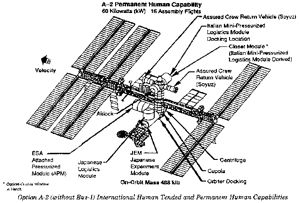 | Station Option A '93 Space Station Options 1993 Credit: NASA via Marcus Lindroos |
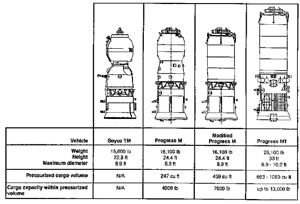 | Station Option A-Rus Space Station Options 1993 Credit: NASA via Marcus Lindroos |
 | Station Option A-Rus Space Station Options 1993 Credit: NASA via Marcus Lindroos |
 | Station Option C '93 The Option C Space Station would have been launched in one piece on a new unmanned Shuttle-derived heavy-lift rocket. Credit: NASA via Marcus Lindroos |
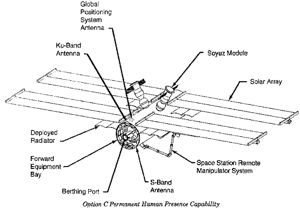 | Station Option C '93 Space Station Options 1993 Credit: NASA via Marcus Lindroos |
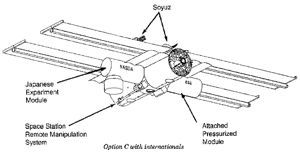 | Station Option C '93 Space Station Options 1993 Credit: NASA via Marcus Lindroos |
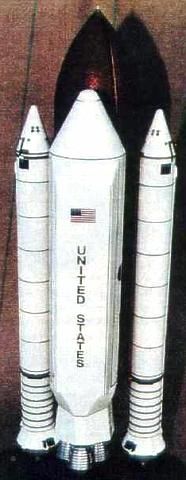 | Space Station C5 Space Station Option C5 Credit: NASA via Marcus Lindroos |
 | Space Station C6 Space Station Option C6. This illustration show the Shuttle, ESA Columbus and Japanese Experiment Modules docked to the Option C Space Station. Credit: NASA via Marcus Lindroos |
Back to top of page
Home - Search - Browse - Alphabetic Index: 0- 1- 2- 3- 4- 5- 6- 7- 8- 9
A- B- C- D- E- F- G- H- I- J- K- L- M- N- O- P- Q- R- S- T- U- V- W- X- Y- Z
© 1997-2019 Mark Wade - Contact
© / Conditions for Use
